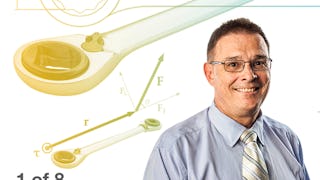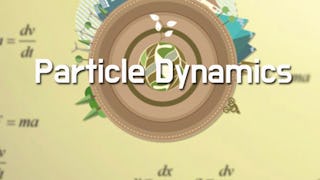This course is an introduction to the study of bodies in motion as applied to engineering systems and structures. We will study the dynamics of particle motion and bodies in rigid planar (2D) motion. This will consist of both the kinematics and kinetics of motion. Kinematics deals with the geometrical aspects of motion describing position, velocity, and acceleration, all as a function of time. Kinetics is the study of forces acting on these bodies and how it affects their motion.


Engineering Systems in Motion: Dynamics of Particles and Bodies in 2D Motion

Instructor: Dr. Wayne Whiteman, PE
52,083 already enrolled
(746 reviews)
Skills you'll gain
Details to know

Add to your LinkedIn profile
7 assignments
See how employees at top companies are mastering in-demand skills

There are 7 modules in this course
In this section students will learn about particle kinematics, Newton's Laws and Euler's Laws, motion of particles and mass centers of bodies.
What's included
8 videos17 readings1 assignment
In this section students will learn the work-energy principle for particles/systems of particles, impulse and momentum, impact, conservation of momentum and Euler's 2nd Law - Moment of momentum.
What's included
5 videos8 readings1 assignment
In this section students will learn about planar (2D) rigid body kinematics, relative velocity equation, rotation about a fixed axis, instantaneous center of zero velocity, and relative acceleration equations.
What's included
6 videos11 readings1 assignment
In this section students will continue to learn about planar (2D) rigid body kinematics, relative velocity equation, rotation about a fixed axis, instantaneous center of zero velocity, and relative acceleration equations.
What's included
8 videos12 readings1 assignment
In this section students will learn about planar (2D) rigid body kinetics, translation, moment of momentum - angular momentum, and equations of motion.
What's included
6 videos11 readings1 assignment
In this section students will continue to learn about planar (2D) rigid body kinetics using the Work-Energy Method.
What's included
9 videos11 readings1 assignment
In this section students will continue to learn about planar (2D) rigid body kinetics using the Impulse-Momentum Method and Conservation of Momentum.
What's included
5 videos10 readings1 assignment
Instructor

Offered by
Explore more from Mechanical Engineering
 Status: Preview
Status: PreviewGeorgia Institute of Technology
 Status: Preview
Status: PreviewGeorgia Institute of Technology
 Status: Preview
Status: PreviewGeorgia Institute of Technology
 Status: Preview
Status: PreviewKorea Advanced Institute of Science and Technology(KAIST)
Why people choose Coursera for their career




Learner reviews
746 reviews
- 5 stars
89.54%
- 4 stars
8.71%
- 3 stars
1.20%
- 2 stars
0.40%
- 1 star
0.13%
Showing 3 of 746
Reviewed on Oct 4, 2020
This course is very important to every Mechanical Engineering students, this is very useful to me for improving our subject.Thank you for giving opportunity.
Reviewed on Aug 28, 2020
A brilliant course, gave me a great foundation for more advanced courses in mechanical engineering. When ever i use some of the things i learned in this course in my work i think of Whiteman.
Reviewed on Jun 18, 2016
It's really good. I am revising these concepts in the best possible ways through this course!

Open new doors with Coursera Plus
Unlimited access to 10,000+ world-class courses, hands-on projects, and job-ready certificate programs - all included in your subscription
Advance your career with an online degree
Earn a degree from world-class universities - 100% online
Join over 3,400 global companies that choose Coursera for Business
Upskill your employees to excel in the digital economy
Frequently asked questions
To access the course materials, assignments and to earn a Certificate, you will need to purchase the Certificate experience when you enroll in a course. You can try a Free Trial instead, or apply for Financial Aid. The course may offer 'Full Course, No Certificate' instead. This option lets you see all course materials, submit required assessments, and get a final grade. This also means that you will not be able to purchase a Certificate experience.
When you purchase a Certificate you get access to all course materials, including graded assignments. Upon completing the course, your electronic Certificate will be added to your Accomplishments page - from there, you can print your Certificate or add it to your LinkedIn profile.
Yes. In select learning programs, you can apply for financial aid or a scholarship if you can’t afford the enrollment fee. If fin aid or scholarship is available for your learning program selection, you’ll find a link to apply on the description page.
More questions
Financial aid available,

